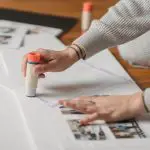Are you wondering if you can use hot glue on fabric? The answer is yes! Hot glue can be a great tool for crafting and DIY projects, and it can be a useful adhesive for attaching fabric to other surfaces. However, there are some important things to keep in mind when using hot glue on fabric to ensure that your project turns out well.
First, it’s important to understand the properties of hot glue. Hot glue is a type of thermoplastic adhesive that melts when heated and solidifies when cooled. This means that it can bond to a wide variety of surfaces, including fabric, but it can also be prone to melting or becoming brittle in extreme temperatures.
Understanding how hot glue works and how to use it properly can help you achieve the best results when working with fabric.
Table of Contents
Understanding the Properties of Hot Glue
You’re gonna love how easy it is to understand the properties of hot glue! Hot glue is a type of thermoplastic adhesive that’s applied using a hot glue gun.
The glue is made from a combination of resin and wax, which is melted when heated and solidifies when cooled.
Hot glue is a versatile adhesive that can be used on a variety of materials, including fabric. It’s ideal for use on fabric because it dries quickly and creates a strong bond.
Before using hot glue on fabric, it’s important to ensure that the fabric is clean and free of any dust or debris.
When using hot glue on fabric, it’s important to keep in mind that the glue will dry hard and may become brittle over time. This can cause the fabric to become stiff or even crack.
To prevent this, it’s best to use hot glue sparingly and only in areas where it’s needed. By understanding the properties of hot glue, you can confidently use it on fabric and other materials in your next project.
Types of Fabrics That Can Be Used With Hot Glue
Finding the perfect material to work with your adhesive is crucial to ensure your project’s success. When it comes to hot glue and fabric, there are a few things you should keep in mind.
First, consider the weight and texture of the fabric. Thin, lightweight fabrics like cotton or silk may not hold up well with hot glue, while heavier fabrics like denim or felt can withstand the heat.
Another factor to consider is the intended use of the fabric. If you’re using hot glue to attach decorative elements to a piece of fabric that won’t be subjected to much wear and tear, then almost any type of fabric can be used. However, if you’re attaching fabric to a surface that will be frequently handled or washed, it’s important to choose a fabric that can withstand the heat and hold up to repeated use.
It’s important to test the hot glue on a small, inconspicuous area of the fabric before committing to your project. This will help you determine if the glue is compatible with the fabric and ensure that it won’t damage or discolor the fabric.
With a little bit of experimentation and some careful consideration, you can use hot glue to create beautiful, durable fabric projects.
Preparing the Fabric for Hot Glue
To ensure the success of your fabric project, it’s important to take the necessary steps in preparing the material for bonding with adhesive.
One of the first things you should do is wash and dry the fabric to remove any dirt, oils, or sizing that may be on it. This will give the hot glue a clean surface to bond to and increase the chances of a strong hold.
After washing and drying the fabric, you should then iron it to remove any wrinkles or creases. This will help the fabric lay flat and prevent any puckering or bubbling that may occur when applying the hot glue. It’s important to use a low to medium heat setting on your iron to avoid damaging the fabric.
Before applying the hot glue, you may want to test it on a small, inconspicuous area of the fabric to make sure it doesn’t cause any discoloration or damage. Once you have confirmed that the hot glue is safe to use on your fabric, you can then begin applying it to your project.
By taking these simple steps to prepare your fabric for hot glue, you can ensure a successful and long-lasting bond.
Applying Hot Glue to Fabric
Now that you’ve prepped your fabric, it’s time to start gluing!
To ensure success, you’ll want to choose the right glue gun for your project.
Once you have the right tool, it’s important to apply the glue carefully and evenly.
Don’t forget to adjust the temperature as needed to avoid burning or melting your fabric.
Choosing the Right Glue Gun
Picking the perfect glue gun for your fabric project can be a fun and creative process! There are a few factors to consider before choosing which one to use.
Firstly, you need to think about the type of fabric you’re working with. If it’s a delicate or synthetic material, then a low-temperature glue gun is ideal. On the other hand, if you’re working with a thicker and tougher fabric like denim or leather, then a high-temperature glue gun is necessary.
Another thing to consider is the size of the glue gun. If you’re working on a small project, then a mini glue gun would be perfect. However, if you’re working on a larger project, then a standard-sized glue gun would be more efficient.
Also, keep in mind the type of glue sticks that are compatible with the glue gun you choose. Some glue guns can only use specific types of glue sticks, while others are more versatile.
By taking these factors into consideration, you can choose the right glue gun for your fabric project and ensure a successful outcome.
Applying the Glue
When selecting the appropriate glue gun for your project, it is important to understand the proper technique for applying the adhesive to your fabric. Once you have chosen the right glue gun, it’s time to start applying the hot glue to your fabric. To ensure that your glue adheres properly, there are a few important steps to follow.
First, make sure that your fabric is clean and dry. Any dirt or moisture can prevent the glue from sticking properly. Next, apply the hot glue in a thin, even layer to one side of the fabric. Be sure to work quickly, as hot glue can dry fast. Finally, firmly press the two surfaces together, making sure that they are aligned properly. If you need to make any adjustments, do so quickly before the glue sets. By following these steps, you can ensure that your hot glue will adhere properly to your fabric and provide a strong bond that will last.
To make things easier, here is a table outlining the steps for applying hot glue to fabric:
| Step | Description |
|---|---|
| 1 | Clean and dry the fabric |
| 2 | Apply hot glue in a thin, even layer to one side of the fabric |
| 3 | Quickly press the two surfaces together, aligning them properly |
| 4 | Make any necessary adjustments before the glue sets |
With this table, you can easily keep track of the steps and make sure that you are following them correctly. So go ahead and grab your hot glue gun, choose the right glue for your project, and start applying your adhesive to your fabric like a pro!
Adjusting the Temperature
Don’t let a high or low temperature setting ruin your project – adjust the temp on your glue gun to get the perfect adhesive for your materials!
When using hot glue on fabric, it’s important to keep the temperature in mind. A temperature that is too high can cause the glue to burn through the fabric, while a temperature that is too low can result in the glue not adhering properly.
Here are some tips for adjusting the temperature:
-
Start with a low temperature and gradually increase it until you find the right setting.
-
Use a thermometer to check the temperature of the glue as it comes out of the gun.
-
If you’re not sure what temperature to use, do a test on a scrap piece of fabric first to avoid damaging your project.
By taking the time to adjust the temperature of your glue gun, you can ensure that your hot glue will properly adhere to your fabric and create a strong bond. So don’t rush the process and take the time to find the right temperature for your project!
Tips for Using Hot Glue on Fabric
Using hot glue on fabric can be a great way to quickly and securely attach embellishments or pieces together. However, it’s important to follow a few tips to ensure the best results.
Firstly, make sure to choose the right type of hot glue. For fabric, it’s best to use a low temperature glue gun and glue sticks specifically designed for fabric. This will prevent the glue from burning or melting the fabric, and will also ensure a strong bond.
Secondly, it’s important to apply the glue sparingly and strategically. Too much glue can create a mess and potentially seep through the fabric. Apply small amounts of glue in key areas, and press the pieces together firmly for a few seconds to allow the glue to set.
Lastly, be careful when handling the fabric while the glue is still hot. It’s easy to accidentally burn yourself or shift the pieces before the glue has set. Wait a few minutes for the glue to cool and fully set before handling the fabric again.
By following these tips, you can use hot glue on fabric with confidence and achieve great results.
Limitations of Hot Glue on Fabric
When using hot glue on fabric, it’s important to keep in mind its limitations. Heat sensitivity is one of the key points to consider, as too much heat can cause the glue to melt and lose its effectiveness.
Additionally, while hot glue is durable, it may not be the best choice for projects that require a lot of flexing or movement. Keep these factors in mind when deciding whether or not to use hot glue on your fabric project.
Heat Sensitivity
You’ll want to be careful when using hot glue on fabric, as it can be sensitive to high temperatures and may cause damage. Some fabrics, such as polyester and nylon, are particularly susceptible to heat and can melt or warp when exposed to hot glue. This can result in unsightly marks or permanent damage to the fabric, which can be difficult or impossible to repair.
To avoid damage, it’s important to use a low-temperature hot glue gun and to test a small, inconspicuous area of the fabric before applying glue to the entire surface. Additionally, it’s important to avoid using hot glue on delicate fabrics, such as silk or lace, which can be easily damaged by heat.
By taking these precautions, you can safely use hot glue on fabric without causing any damage or ruining your project.
Durability
Now that you know about the sensitivity of fabric towards heat, let’s talk about the durability of hot glue on fabric. Hot glue is a popular adhesive for DIY projects and crafts, but can it withstand the wear and tear of everyday use on fabric? The answer is that it depends on the type of fabric and the conditions it will be exposed to.
When hot glue is applied to fabric, it forms a strong bond that can last for a long time. However, if the fabric is subjected to constant movement or stress, such as in a piece of clothing or a bag, the bond may weaken over time. Additionally, extreme temperatures can cause the glue to soften or harden, which can affect its durability.
Here are some factors that can impact the durability of hot glue on fabric:
- Type of fabric
- Type of hot glue
- Amount of glue applied
- Conditions the fabric will be exposed to
Overall, hot glue can be a useful adhesive for fabric projects, but it may not be the best choice for items that will be frequently used or exposed to extreme conditions. Consider the type of fabric and the intended use of the item before deciding to use hot glue as an adhesive.
Flexibility
To achieve a more flexible and versatile adhesive for your fabric projects, it’s worth exploring alternative options beyond hot glue. While hot glue is popular due to its quick-drying and strong bonding properties, it may not be the best choice for fabrics that require flexibility. Hot glue can harden and become brittle over time, which can cause the fabric to crack or tear.
Instead, consider using fabric glue or a glue specifically designed for flexible materials. Fabric glue is designed to bond with fabrics and maintain their flexibility, making it a great option for projects like hemming or attaching patches. There are also many types of flexible adhesives on the market that can bond with a variety of materials, including fabrics. These adhesives can be a great choice for projects that require a strong bond without sacrificing flexibility.
By exploring alternative adhesive options, you can ensure that your fabric projects are not only durable but also maintain their flexibility over time.
- Is Pure Chiffon Costly? - April 23, 2024
- What Is Similar to Chiffon? - April 23, 2024
- Which Material Is Better Crepe or Chiffon? - April 23, 2024





